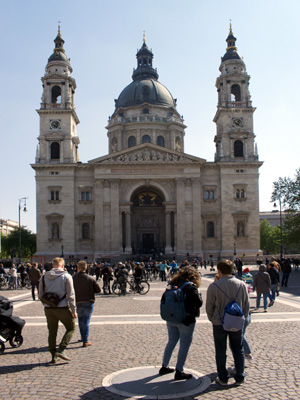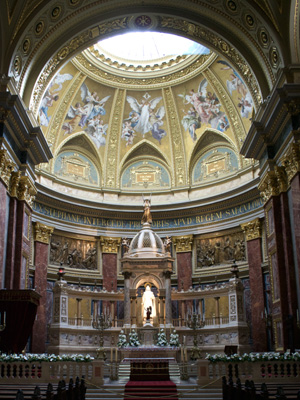| |
 |
 |
 |
| Comment on this report, or find other reports. |
 |
| Our Mystery Worshippers are volunteers who warm church pews for us around the world. If you'd like to become a Mystery Worshipper, start here. |
 |
| Find out how to reproduce this report in your church magazine or website. |
|
|
| 3157: Szent István Bazilika, Budapest, Hungary |
 |
 |
 |
Mystery Worshipper: Columba's Currach.
The church: Szent István Bazilika (St Stephen's Basilica), Budapest, Hungary.
Denomination: Roman Catholic, Archdiocese of Esztergom-Budapest.
The building: The massive neo-classical church, begun in 1851 and completed in 1906, is an important symbol of the city. At 96 meters, it's one also one of the tallest buildings in the city. The interior is a riot of polychromatic marble and gold leaf. It's not too far from being a Central European version of London's St Paul's Cathedral.
The church: St Stephen's ranks as a minor basilica. It is also the co-cathedral of the archdiocese, and thus one of the two seats of the grandly-titled Prince Primate of Hungary. However, within the archdiocese, it is second in rank to Esztergom Basilica, which is a larger church in a much smaller city. It's greatest claim to prominence has historically been the Holy Right of St Stephen. This relic is the mummified right hand of King Stephen I of Hungary (r. 975-1038), who is credited with christianizing Hungary and is thus venerated as a saint.
There are three masses a day on weekdays, and five on Sundays, including one in English. Confessions are heard in Hungarian, English, and French. The basilica also hosts an extensive series of concerts.
The neighbourhood: St Stephen's is located in central Pest, the bustling commercial and residential part of Budapest. Traditionally, this was the church for the people of the city, as opposed the royal church of St Matthias across the Danube in Buda.
The cast: No names were given. The celebrant was a young priest, assisted by two much older deacons, one of whom fulfilled the role that would be done by the subdeacon in a Tridentine/extraordinary form mass. There was also a team of seven servers (all adult men). The choir, located in a loft, was heard but not seen.
The date & time: Second Sunday of Easter, 23 April 2017, 10.00am.
What was the name of the service?
Nagymise (Great Mass in the Latin Language).
How full was the building?
There must have been a few hundred people there.
Did anyone welcome you personally?
No.
Was your pew comfortable?
The dark wood pew with that legendary creature the gryphon (griffin) carved on the end, and a thin cushion, was perfectly comfortable. The unpadded wooden kneeler was not.
How would you describe the pre-service
atmosphere?
There was a crowd of tourists at the door and in the back of the nave. But once one passed into the space reserved for worshippers, it was surprisingly quiet and reverent.
What were the exact opening words of the
service?
The introit for the day (which gives this Sunday the name, sometimes heard, of Quasimodo Sunday): "Quasi modo geniti infantes, Alleluia,
rationabiles sine dolo lac concupiscite, Alleluia ..." (As newborn babes, Alleluia, seek ye the milk of reason, without guile, Alleluia ...) sung by the invisible choir. The first spoken words were the Trinitarian invocation in a different language: "Vu iméni Ocsé, i Sziná, i Dühá, szvétoga Ámen." I was quite taken aback by this, as it was advertised as a Latin service. In reality, it was about half Latin and half another language.
What books did the congregation use during the
service?
None. Congregational responses were projected onto a screen, which was somewhat surprising as this was otherwise a very traditional mass.
What musical instruments were played?
The organ. I gather this is a very famous instrument. But, rather through differences in the style of organ building or playing, it had a sound that reminded me more of a theatre organ than anything I've heard in England, France, or Germany. That's an observation rather than a complaint – I quite enjoyed it!
Did anything distract you?
The frequent switches between languages were distracting. For the Liturgy of the Word alone, we had the Kyrie in Greek, the Gloria and collect in Latin, and the readings in Hungarian but with the chants in between in Latin. The pace of change calmed down a bit after the Orate Fratres (in Hungarian), as the entire eucharistic prayer was in Latin. Then for some reason, we switched to Hungarian for the invitation to communion. Finally it was back to Latin again for the blessing and dismissal.
I was also pleasantly distracted by some local customs. My favourite of these was that people crossed themselves when the deacon censed them.

Was the worship stiff-upper-lip, happy clappy, or
what?
This was definitely on the more traditional end of Roman Catholicism, with chanting, incense, and a large all-male serving team. Communion was received in one kind only, standing, but on the tongue, with a server holding a paten under the chin. Other than being celebrated facing the people, this would probably have satisfied all but the most ardent advocates of the "reform of the reform."
Exactly how long was the sermon?
8 minutes.
On a scale of 1-10, how good was the preacher?
? – I really couldn't say. The priest spoke without much expression. He could have been either deeply humble or just utterly lacking in people skills. Not knowing Hungarian, I couldn't tell which.
In a nutshell, what was the sermon
about?
No idea, sorry.
Which part of the service was like being in
heaven?
The beautiful building, the clouds of incense, and the Gregorian chants.
And which part was like being in... er... the other place?
Nothing about the service per se, but as an Anglican I was saddened to think about our disunity. In a church so strongly associated with Hungarian identity, I was also saddened to think about the current repressive government.
What happened when you hung around after the service looking lost?
People left quickly.
How would you describe the after-service
coffee?
There was none offered in the church, but the area is filled with many good coffee shops, to which I repaired alone.
How would you feel about making this church your regular (where 10 = ecstatic, 0 = terminal)?
3 – If I lived in Budapest, I'd probably come on big feasts. Anglican churches are thin on the ground here, and the liturgy interpreted conservatively is my preferred type of Roman Catholic liturgy. But I think I'd need to learn more Hungarian to make this my regular service! I might check out the 6.00pm English mass instead.
Did the service make you feel glad to be a
Christian?
Yes.
What one thing will you remember about all this in seven days' time?
The constant and confusing switching from Latin to Hungarian. |
|
|
 |
 |
 |
| We rely on voluntary donations to stay online. If you're a regular visitor to Ship of Fools, please consider supporting us. |
 |
 |
 |
| The Mystery Pilgrim |
 |
| One of our most seasoned reporters makes the Camino pilgrimage to Santiago de Compostela in Spain. Read here. |
 |
 |
 |
| London churches |
 |
| Read reports from 70 London churches, visited by a small army of Mystery Worshippers on one single Sunday. Read here. |
| |
|
|
|
|


